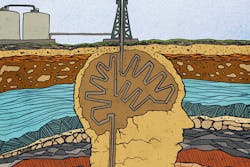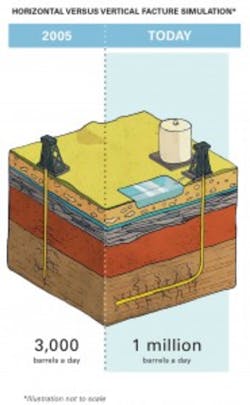Smarter hydraulic fracturing for better water management
To the crew of the International Space Station 220 miles above Earth, it looks like the U.S. has added a mammoth new city aglow at night near the Canadian border. Yet just six years ago, this area several hundred miles west of the Great Lakes was virtually dark. How could this be?
The new mystery "city" lights come from hydraulic fracturing by more than 150 oil companies tapping what is known as the Bakken Formation. The 200,000-square-mile oil field – an area as large as California and Indiana combined – covers parts of North Dakota, Montana and Saskatchewan. The area’s output of nighttime light, easily seen from Earth’s orbit, comes from thousands of new oil rigs pumping around the clock, as well as from fiery natural gas flares, discharged and burnt off at oil fields to keep production equipment from overpressure.
Altogether, the wells atop the Bakken are pumping a million barrels of crude oil a day, according to 2013 year-end data from the U.S. Energy Information Administration. That’s five times the Bakken’s daily oil output from 2010, and enough to vault North Dakota to the second-largest oil-producing state, after Texas.1
A growing source of energy
Oil- and gas-producing shale formations are not limited to just the Bakken Formation, but are also found in continents and countries around the world. According to the U.S. Energy Information Administration, shale formations globally contain nearly one-third (32 percent) of estimated natural gas resources and 10 percent of estimated global oil resources.2
Shale-based oil extraction is gradually enabling nations like the U.S. to achieve a pronounced measure of energy independence. In October 2013, the U.S. surged past Saudi Arabia to become the world’s top oil producer, at 12.1 million barrels per day. Based on such production, a 2012 Citigroup report indicated that in just five years the U.S. might no longer need to import oil from any source except Canada, and that combined U.S. and Canadian oil output might be in surplus of projected needs.3,4
As hydraulic fracturing grows, so do water concerns
While hydraulic fracturing has cracked open an economic bonanza at the Bakken and dozens of other production sites worldwide, it has also created concerns over its environmental impact, especially around ground water supply and quality. Water is integral to nearly all hydraulic fracturing operations.
Courtesy of Dow Water and Process Solutions.
Hydraulically fracturing a typical new horizontal shale gas or tight oil well requires 3 to 5 million gallons of water, with large multistage fracturing operations commonly requiring over 10 million gallons. To get an idea of how much water that is, if you left your bathroom faucet on non-stop for about a year, you would use about 1 million gallons. (Bath faucets generally run at 1.5-2 gallons of water per minute.)5,6
Yet hydraulic fracturing-related water use doesn’t necessarily stop after the well has been opened. Due to the Bakken’s high-salinity groundwater, its more than 10,000 currently producing wells (as of July 2015) each require more than 600 gallons of maintenance water a day to prevent salt build-up from restricting oil flow, according to North Dakota’s Department of Mineral Resources (DMR). Over an average Bakken well’s 30- to 40-year projected lifespan, that’s an additional 6.6 million to 8.8 million gallons of water needed for each well.7
In the next 10 to 20 years, when the Bakken is fully developed, DMR officials project it will have 40,000 to 45,000 producing wells, which will need as much as 10.2 billion gallons in maintenance water to keep producing oil.7
As this shows, widespread energy production is not possible without water, just as water distribution without energy is impossible. Private and public sector leaders must join forces to ensure that energy extraction processes like hydraulic fracturing also employ the latest in water treatment and conservation processes and technologies.
Water recycling to address environmental concerns
Hydraulic fracturing is often performed in areas where water is scarce such as the western regions of North Dakota and southwest Texas or near major population centers such as Pennsylvania, so water recycling is seen as important for reducing the impact of hydraulic fracturing on local water resources as well as infrastructure. For example, in one study of the Marcellus Shale oil and gas producing region of Pennsylvania, nearly 90 percent of reported flowback water was mostly reused.9
Companies in the industry offer a range of advanced chemistry and technology solutions for water treatment to help producers improve shale-based oil and gas recovery while minimizing the environmental impact during the hydraulic fracturing process.
For instance, in Texas the Eagle Ford hydraulic fracturing operations rely on an innovative mobile water treatment unit to treat flowback and produced waters. The unit reduces water hardness and boron levels with ultrafiltration reverse osmosis membrane technologies. Water recycled from the unit can then be reused for additional drilling and hydraulic fracturing operations.
As another example, an oil and gas producer in the Western U.S. began using a self-cleaning US fine particle filter for solids removal from produced and flowback water. For years, the company had been using traditional bag filters at its centralized well injection sites. By switching to this new product, the company not only achieved a 99.5 percent water recovery rate with improved solids removal, but by eliminating the need for bag filter change-outs, the company was also able to reduce its staffing requirements.
Additionally, in late 2013 a major oil and gas producer in Riverton, Wyoming, built what will be the third-largest water treatment plant of its kind in the world. It can treat as many as 1 million gallons of water a day, treat 750 gallons of produced water per minute and create 900,000 gallons of clean water per day.
Examples such as these demonstrate how technology-led water treatment solutions can ultimately lead to superior outcomes for both producers and the environment.
The future of hydraulic fracturing
Hydraulic fracturing can be an efficient and environmentally contained process to extract oil and gas, as long as producers follow industry best practices and use the most appropriate extraction technologies possible in all phases of the process.
However, not all industry regulators are convinced. Several individual U.S. counties and three states – New Jersey, New York and Vermont – have enacted bans or temporary moratoriums on hydraulic fracturing. Additionally, at least three European Union members – the Czech Republic, France and Romania – have adopted temporary hydraulic fracturing moratoriums.
To assess the current status of the hydraulic fracturing industry and potential opportunities for improvement, several governments are studying hydraulic fracturing’s environmental impact. In the U.S., for example, Congress asked the Environmental Protection Agency (EPA) to review the effect of hydraulic fracturing on drinking water resources. While the EPA report did not find evidence that hydraulic fracturing mechanisms led to widespread, systemic impacts on drinking water resources in the U.S., the debate continues over the industry’s use, reuse and disposal of water.9
Because of the relative newness of hydraulic fracturing, producers and regulators must continue to explore ways to adopt water treatment processes and technologies to ensure sustainable industry practices.
Snehal Desai is the global business director for Dow Water & Process Solutions. He is responsible for implementing the company’s business growth strategy and leading 1,700 people. Desai is an expert on industry and global issues such as water scarcity, quality and safety along with the interdependencies of water and energy.
Aaron M. Johnson is the growth technology leader for Dow Water & Process Solutions’ Oilfield Water platform. Since 2009, he has been responsible for establishing and leading programs to develop and commercialize solutions to water challenges facing the hydrocarbon exploration and production industry. His research efforts include new products, as well as application-driven research on membranes, ion exchange and specialty adsorbent technologies.
To learn more about Dow Water & Process Solutions technologies and hydraulic fracturing, download Dow’s white paper on "Sustainable Water Management: A Key Component to Shale Oil & Gas Operations" and visit dowwaterandprocess.com.
Resources
- U.S. Energy Information Administration, Nov. 15, 2013, www.eia.gov/todayinenergy/detail.cfm?id=13811.
- U.S. Energy Information Administration, June 10, 2013, www.eia.gov/analysis/studies/worldshalegas/.
- PIRA Energy Group, Oct. 15, 2013, www.pira.com/news-press/pira-energy-news/2013/10/15/PIRA-Energy-Group-Reports-that-the-U-S-Is-Now-the-World-s-Largest-Oil-Supplier.
- Citigroup, March 20, 2012. www.citivelocity.com/citigps/ReportSeries.action?recordId=6.
- Congressional Research Service, "Unconventional Gas Shales: Development, Technology, and Policy Issues," Oct. 30, 2009. www.fas.org/sgp/crs/misc/R40894.pdf.
- U.S. Environmental Protection Agency, www.epa.gov/WaterSense/pubs/indoor.html.
- National Geographic, "North Dakota’s Salty Fracked Wells Drink More Water to Keep Oil Flowing," www.news.nationalgeographic.com/news/energy/2013/11/131111-north-dakota-wells-maintenance-water/.
- Duke University, "Hydraulic Fracturing Produces Less Wastewater Per Unit of Gas, But More Overall," Jan. 22, 2013, www.nicholas.duke.edu/news/hydraulic-fracturing-produces-less-wastewater-per-unit-of-gas-but-more-overall.
- EPA, "Assessment of the Potential Impacts of Hydraulic Fracturing for Oil and Gas on Drinking Water Resources Executive Summary", EPA/600/R-15/047a, June 2015, www.epa.gov/hfstudy.

